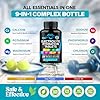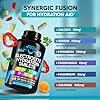In their test, one out of thirteen participants (7%) tested positive for PEGylated proteins after 24 hours post-vaccination. And while statistical analysis of the other samples showed no significant difference in PEGylated proteins between pre and post-vaccine breast milk, their study demonstrated that PEG could be excreted in breast milk post-COVID vaccination.
While 7% may be small, in 100,000 lactating mothers, that will be 7,000.
Below is a Figure from the study. Any color other than black from the Post-vaccine (PV) column is positive for PEG.

Why is the presence of PEG in breast milk significant?
When the mRNA COVID shots were released, no one knew if anyone could be allergic to the vaccine excipients. That’s because, in phase 2 and 3 clinical trials for the currently approved vaccines, participants with a known or suspected allergy to PEG and polysorbate 80 were excluded.[5] (Greenhawt)
In the article published in the British Journal of Anesthesiology by Garvey and Nasser, Anaphylaxis to the first COVID-19 vaccine: is polyethylene glycol (PEG) the culprit?[3]
The vaccine contains a number of excipients and lipids, one of them based on PEG-2000. This is currently the only excipient in the vaccine with recognized allergenic potential
The case report, Polyethylene glycol (PEG), is a cause of anaphylaxis to the Pfizer/BioNTech mRNA COVID‐19 vaccine, demonstrated the cause and effect using skin prick testing in a 52-year-old woman.
Twelve minutes after skin testing, and 2 minutes after the skin test became positive, she developed a systemic reaction with widespread pruritus, urticaria and coughing with throat constriction.
Systolic blood pressure dropped from 137 mm Hg to 107 mm Hg. She was treated in clinic with intramuscular adrenaline 0.5 mg, intravenous chlorphenamine 10 mg and hydrocortisone 200 mg.
Her blood pressure improved but coughing persisted, with a drop in oxygen saturation to 85%. A second dose of intramuscular adrenaline 0.5 mg was administered, and she rapidly improved.
PEG allergy was diagnosed as the cause of her Pfizer/BioNTech vaccine anaphylaxis.
What is Polyethylene Glycol?
Polyethylene Glycol is a common ingredient in many products, and it is in shampoos, conditioners, shower gels, laxatives, over-the-counter and prescription medications, and vaccines. Usually, people who have allergies to many medicines are allergic to PEG.
Because of its ubiquity, it is not surprising that many will have antibodies against PEG. In one study, as many as 25% of healthy blood donors have anti-PEG antibodies.
Allergy and Anaphylaxis
Allergy is a hypersensitivity reaction. People are usually sensitized to one substance, and their immune systems develop antibodies against it. Upon subsequent exposure, an allergic response can present in the form of a rash.
Fever can also happen because the blood vessels dilate and release heat during an allergic reaction. Mast cells can also get activated and produce an allergic response.
Anaphylaxis is a severe allergy and manifests as low blood pressure and throat constriction. That is what happened to the patient mentioned above.
In infants, sensitization can happen inside the uterus. The mother takes medicine with PEG, crosses the placental barrier, and goes to the fetus. A study has demonstrated PEG in the placenta.
Depending on the immune system, some fetuses may develop antibodies to the PEG and have an allergic reaction if exposed to PEG in breast milk.
That is what may have happened to the following cases reported to VAERS.[4] The allergic reactions occurred one to three days after the mothers received their COVID shots. This list is only a fraction of those reported in VAERS. The numbers on the left are VAERS IDs.
| I’m breastfeeding my 14-month-old son. A couple of days after I received my first dose of the moderna vaccine, he broke out in red spots all over his body. A few days later, he developed a low-grade fever. It’s been one week since I was vaccinated. He does not have a fever anymore, and the red spots are almost all gone. I will pump and dump after the next dose for the days and see if he has any reactions when I resume breastfeeding. |
| An 8-month-old breastfeeding baby developed fever and fatigue about 36 hours after the mother received 2nd dose of the Moderna vaccine. A fever of 101-102 degrees lasted around 48 hours and presented with no other symptoms. The infant was unaffected by the first dose. |
| I developed a fever, nausea, and joint and muscle pain, so I held off on breastfeeding my baby until I started feeling better, but I did not pump. My baby developed a fever and vomiting after I resumed breastfeeding her. She has been sick for over 24 hours. |
| I am a breastfeeding mother of an 8-month-old. Two days after receiving both doses of the COVID-19 vaccine, my daughter broke out in a full-body rash. The rash looked like welts. The rash lasted for seven days, and then she had a very high fever for three days. Both times we were told that there wasn’t anything we could do and that they were unsure of the origination of the body rash and fever. |
| Hello – following my second Pfizer COVID shot, I had a low-grade fever and body aches. 24 hours following this incident, my 100% breastfed 9-month-old baby also had a fever, intense stomach pain, and diarrhea. He was sick for five days. I am writing to report the side effects of Breastmilk on children following the second PFIZER COVID shot. |
| Two days after receiving the first dose of the Pfizer COVID vaccine, my 11-month-old breastfed son began having a 102-degree fever. |
| I was diagnosed with shingles on 3-18-21. I started having a rash on 3-15-21. I have been prescribed medication that I just started. I am breastfeeding, and my son developed a rash on 3-15-21. The rash spread from his stomach to his entire body. The rash turned bright red, and bumps appeared on his entire body. The redness decreased starting on 3-17-21. He was seen by a doctor on 3-19-21 and told it was a viral rash likely from the vaccine, but nothing could be done. |
| The patient is two months old. Mom received her 2nd Pfizer Covid vaccine on Friday, 10/15/2021. Mom exclusively breastfeeds the patient, and on Sunday, 10/17/2021 (2 days) patient presented with a rash on various parts of her body. She was seen in our office on 10/19/2021 and evaluated by a doctor. The patient’s rash was described as small red papules on her trunk and back. The patient had no other cold symptoms or recent fevers. There have been no new changes to detergents or foods. The mother did test positive for COVID-19 on 9/20/21, but the patient was not tested then. There was no other clinical explanation for the patient’s rash, and since the vaccine, the mom has also had a significant drop in breast milk production. |
| The patient developed a rash. It was a petechiae-like rash across his chest and stomach. It started 48 hours after I received the shot in the afternoon. After I got the vaccine, I was still breastfeeding him. He did not have any new foods that I believe caused the rash. He received 3 or 4 of his routine vaccines a week before, but I’m not sure of the name of those vaccines he received. He also had covid back in March of 2021 when he was two weeks old. He was also a premature baby born at 34 weeks. He has also been intermittently having daycare colds. |
Note: Petechial rashes are small red spots, usually from low platelet counts.
Truth heals. Lies kill. Don’t Get Sick!
Knowledge about Covid-19 is rapidly evolving. Stay current by subscribing. Feel free to share and like.
Please consider donating to show your support if you find value in this website.
Related:
- Messenger RNA of COVID-19 shots detected in breast milk
- Adverse Reactions to Pfizer Biontech Vaccine for the 5-11 Years Old
- Kounis syndrome can explain vaccine-related heart attacks
- Antibody-Dependent Enhancement in Breastfed Infants
References: (Some references are embedded in the links above)
- Golan Y, et al. COVID-19 mRNA Vaccination in Lactation: Assessment of Adverse Events and Vaccine Related Antibodies in Mother-Infant Dyads. Front Immunol. 2021 Nov 3;12:777103. doi: 10.3389/fimmu.2021.777103. PMID: 34804068; PMCID: PMC8595828.
-
COVID-19 vaccines, Molecular Therapy (2021)
- Garvey LH, Nasser S. Anaphylaxis to the first COVID-19 vaccine: is polyethylene glycol (PEG) the culprit? Br J Anaesth. 2021 Mar;126(3):e106-e108. doi: 10.1016/j.bja.2020.12.020. Epub 2020 Dec 17. PMID: 33386124; PMCID: PMC7834677.
- United States Department of Health and Human Services (DHHS), Public Health Service (PHS), Centers for Disease Control (CDC) / Food and Drug Administration (FDA), Vaccine Adverse Event Reporting System (VAERS) 1990 – 09/29/2022, CDC WONDER On-line Database. Accessed at http://wonder.cdc.gov/vaers.html on Oct 4, 2022, 7:11:04 AM
- Greenhawt M, et al. The Risk of Allergic Reaction to SARS-CoV-2 Vaccines and Recommended Evaluation and Management: A Systematic Review, Meta-Analysis, GRADE Assessment, and International Consensus Approach. J Allergy Clin Immunol Pract. 2021 Oct;9(10):3546-3567. doi: 10.1016/j.jaip.2021.06.006. Epub 2021 Jun 18. PMID: 34153517; PMCID: PMC8248554.
- Sellaturay P et al. Polyethylene glycol (PEG) is a cause of anaphylaxis to the Pfizer/BioNTech mRNA COVID-19 vaccine. Clin Exp Allergy. 2021 Jun;51(6):861-863. doi: 10.1111/cea.13874. Epub 2021 Apr 9. PMID: 33825239; PMCID: PMC8251011.
© 2018 – 2022 Asclepiades Medicine, L.L.C. All Rights Reserved
DrJesseSantiano.com does not provide medical advice, diagnosis, or treatment
As an Amazon Associate, I earn from qualifying purchases.
Nuun Sport Electrolyte Tablets for Proactive Hydration, Mixed Flavors, 4 Pack (40 Servings)
23% OffNuun Hydration Strawberry Lemonade, 10 Tablets
Discover more from Don't Get Sick!
Subscribe to get the latest posts sent to your email.



























